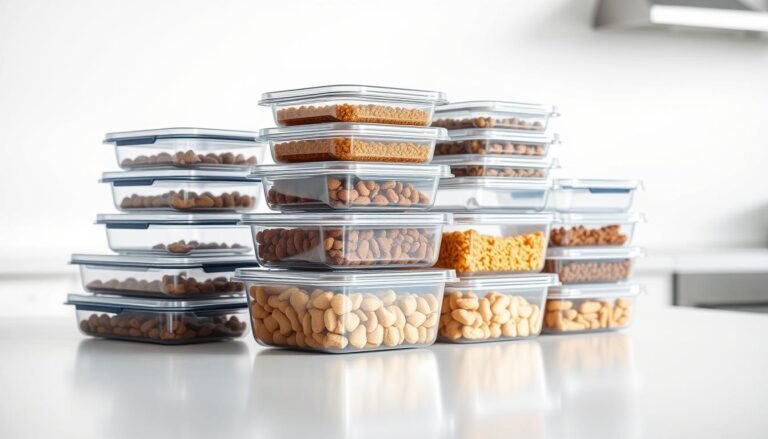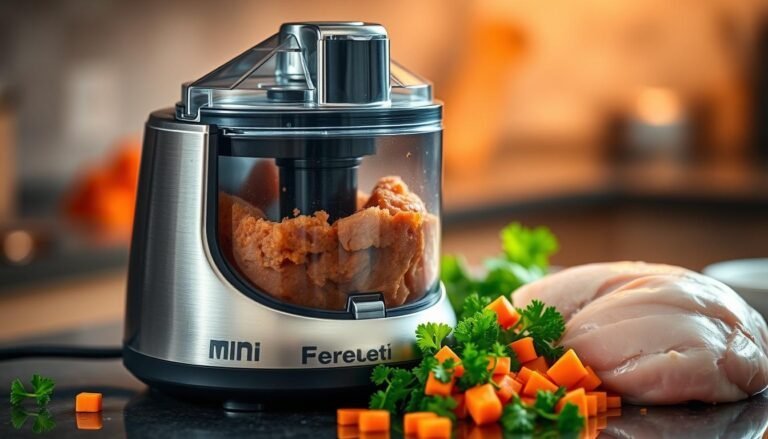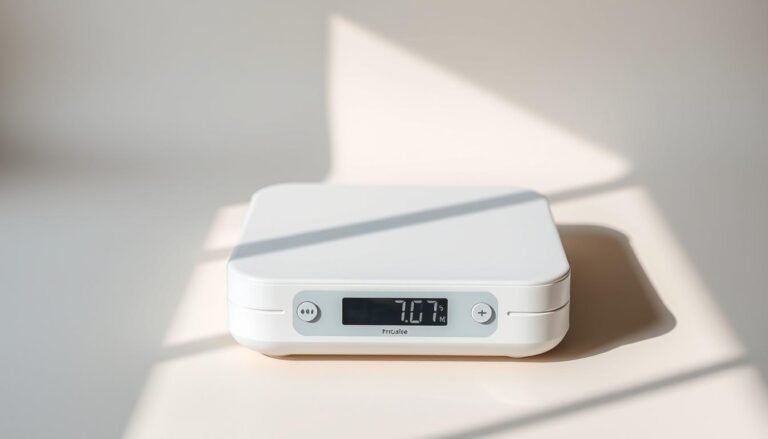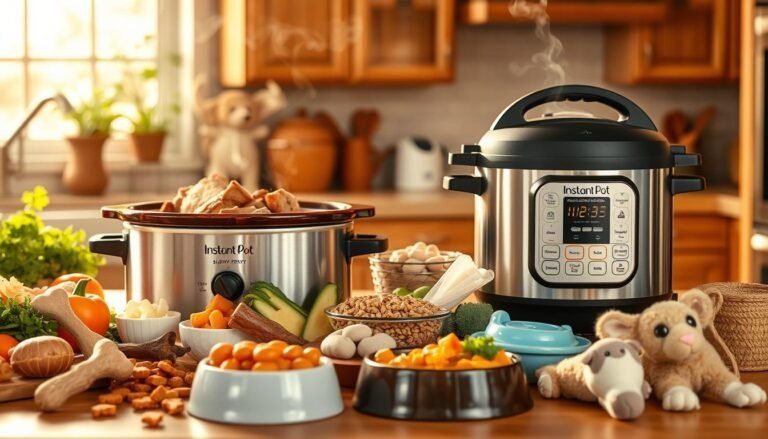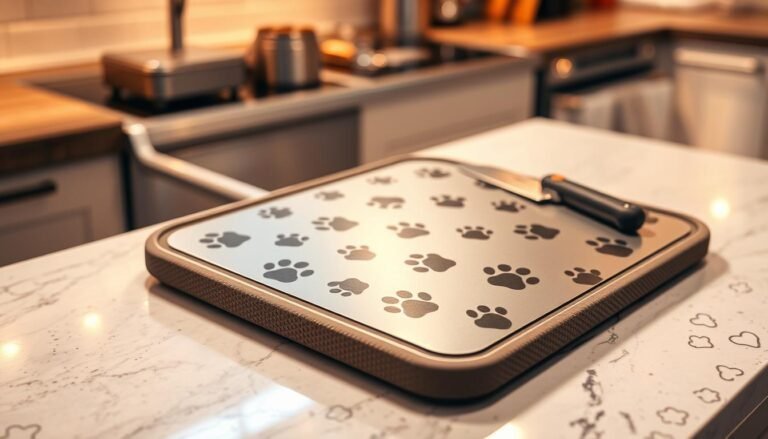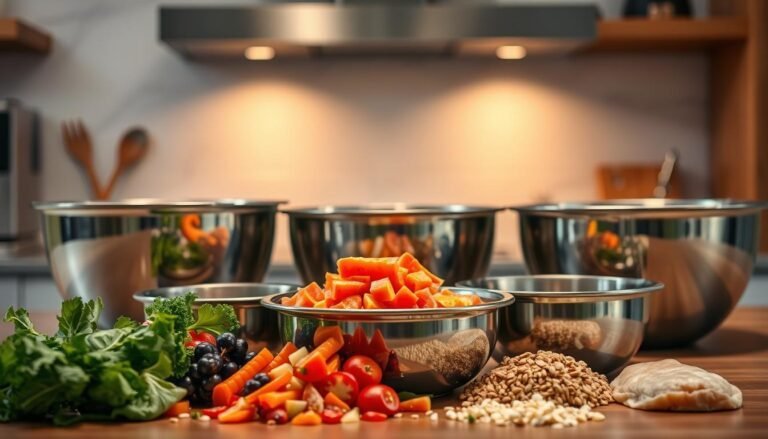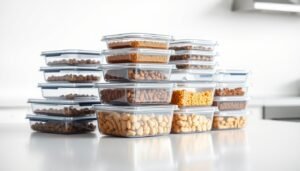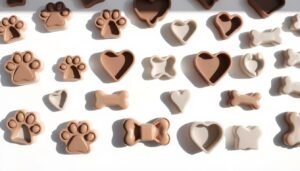Keeping pet food fresh is very important. Dr. Dawn Filos says bad storage can make food go bad and lose nutrients. This can hurt pets.
The right storage containers can stop food from getting old and pests from getting in. Airtight containers are great because they keep air, moisture, and pests out.
Key Takeaways
- Proper pet food storage is crucial for maintaining freshness and nutritional value.
- Improper storage can lead to rancid food and nutrient depletion.
- Airtight containers can prevent nutrient degradation and pest infestation.
- Using the right storage containers can keep pet food fresh for longer.
- Pet owners should prioritize storing pet food in a cool, dry place.
The Importance of Proper Pet Food Storage
Storing your pet’s food right is key to keeping it fresh and nutritious. It’s important to store food properly to keep your pet healthy.
How Improper Storage Affects Pet Food Quality
Bad storage can make pet food go bad. Air, moisture, and heat can spoil the food, reducing its nutritional value.
Nutrient Degradation Over Time
As time goes by, pet food loses nutrients. This happens faster when it’s exposed to air, light, and heat.
Oxidation and Rancidity Issues
When pet food isn’t stored right, it can get oxidized and rancid. This makes harmful compounds, making the food unsafe.
Common Issues with Traditional Storage Methods
Old ways of storing pet food often don’t work well. Problems with the original packaging and open containers can make the food go bad faster.
Problems with Original Packaging
The original packaging might not keep food fresh for long. It leaves the food open to the environment.
Risks of Open Containers
Open containers let pet food get air, moisture, and pests. Using airtight pet food storage containers helps avoid these problems.
Understanding Airtight Pet Food Storage Containers for Freshness and Safety
Keeping pet food fresh and nutritious needs special containers. These containers must be airtight. They keep air, moisture, and pests out.
What Makes a Container Truly Airtight
A container is airtight if it keeps air in or out. This is thanks to seal technologies and mechanisms. For example, the IRIS Airtight Pet Food Storage Container passed tough tests. It didn’t spill when shaken or tipped over.
Seal Technologies and Mechanisms
Good seals are key for airtight containers. They use rubber gaskets, snap-on lids, and screw tops. These seals keep the container fresh.
Testing for Airtight Quality
Manufacturers test containers to make sure they’re airtight. They do pressure tests and check the seals. This shows the container can keep its seal, even when moved or temperature changes.
How Airtight Seals Preserve Nutritional Value
Airtight seals keep pet food fresh by blocking oxygen. Oxygen barrier benefits are a big plus. They stop food from getting rancid and losing nutrients.
Oxygen Barrier Benefits
Oxygen barriers in containers keep pet food from getting spoiled. This is key for keeping food quality high over time.
Extending Shelf Life Statistics
| Storage Method | Shelf Life Extension |
|---|---|
| Airtight Containers | Up to 5 times longer |
| Non-Airtight Containers | Baseline |
Airtight containers make pet food last longer. They can keep food fresh up to five times longer than regular containers. This makes them a smart choice for pet owners.

Key Benefits of Using Airtight Storage Solutions
Airtight pet food storage bins offer many benefits. They keep pet food fresh and safe. This is good for pet health and happiness.
Protection Against Moisture and Humidity
Moisture and humidity can harm pet food. Airtight containers stop moisture from getting in. This stops mold and bacteria from growing.
This is key for foods like dry kibble. Durable pet food containers keep the food dry.
Preventing Pest Infestations
Pests like rodents and ants can get into pet food. Airtight containers keep them out. This lowers the chance of contamination.
This is very important in homes with many pets. The risk of pests is higher then.
Maintaining Flavor and Palatability
Airtight storage keeps pet food tasting good. It stops air from getting in. This prevents fats from going bad and smelling bad.
This makes sure pets want to eat their food. It helps them stay healthy and happy.
| Benefits | Description | Impact on Pet Health |
|---|---|---|
| Protection Against Moisture | Prevents mold and bacterial growth | Reduces risk of gastrointestinal issues |
| Pest Infestation Prevention | Keeps pests like rodents and ants out | Minimizes risk of disease transmission |
| Flavor and Palatability | Maintains freshness and reduces oxidation | Encourages regular eating habits |
Types of Airtight Pet Food Containers
Choosing the right container for pet food is key. It keeps the food fresh and safe. There are many types of containers, each with its own benefits and drawbacks.
Plastic Containers: Pros and Cons
Plastic containers are popular because they’re light and cheap. But, they might not be as durable or safe.
BPA-Free Options
Today, many plastics are BPA-free. This makes them safer for pet food. BPA-free plastic helps avoid chemical contamination.
Durability Considerations
Plastic containers can differ in how long they last. Some break easily. So, pick a sturdy one.
Stainless Steel Options
Stainless steel containers, like the Simplehuman Pet Food Can, are durable and safe. They have tight handles for a secure seal.
Rust-Resistant Features
Stainless steel containers resist rust. This keeps them in good shape for a long time. It’s crucial for keeping pet food quality high.
Insulation Properties
Some stainless steel containers also insulate. This keeps pet food fresh by keeping a steady temperature.
Glass and Ceramic Alternatives
Glass and ceramic containers are also good for pet food. They’re safe and better for the environment than plastic.
| Material | Durability | Non-Toxicity | Cost |
|---|---|---|---|
| Plastic | Variable | BPA-Free Options Available | Low |
| Stainless Steel | High | Yes | Medium to High |
| Glass/Ceramic | High | Yes | Medium to High |

Essential Features to Look for in Pet Food Storage Containers
When picking a pet food storage container, look for key features. These features help keep your pet’s food fresh and safe. A good container can really make a difference in food quality.
Seal Quality and Mechanisms
The seal quality is key to keeping food fresh. It stops air, moisture, and pests from getting in. A tight seal keeps the food’s nutritional value and taste.
Silicone vs. Rubber Seals
Silicone seals, like those in the Ollie Puptainer, are durable and easy to clean. Rubber seals are more affordable but may wear out faster. Choose based on what you value more: durability or cost.
Locking Mechanisms
A locking mechanism adds extra security. It makes sure the container is tightly sealed. This is great for homes with pets that can open simple latches.
Stackability and Space Efficiency
For those with little storage space, stackable containers are a big plus. Look for ones that stack well without losing seal or stability. This keeps your storage area tidy and uses space wisely.
Built-in Scoops and Measuring Tools
A container with a built-in scoop or measuring tool is super handy. It saves you from needing a separate measuring cup and cuts down on spills. This makes feeding time cleaner and more efficient.
In summary, when picking a pet food storage container, think about the seal quality, stackability, and extra features like built-in scoops. These features greatly improve the container’s function and convenience. They help keep your pet’s food fresh and safe.
Size and Capacity Considerations
Choosing the right size of pet food storage bins is key. It keeps food fresh and easy to use. The container’s size should match how much food your pet eats.
Matching Container Size to Pet Food Volume
Think about how much food your pet eats in a short time. For example, the IRIS Airtight Pet Food Storage Container has sizes like a 33-quart one. This can hold up to 25 pounds of food. Picking the right size keeps food fresh and makes it simpler to handle.
Multi-Pet Households: Storage Solutions
Households with many pets need more food storage. Durable pet food containers that are big or extra ones might be needed. It’s important to pick containers that are big enough and keep food fresh. This way, each pet’s food stays fresh and is easy to get to.
Maintenance and Cleaning of Pet Food Containers
Cleaning pet food containers often is key to stop bacteria and keep food safe. It makes the containers last longer and keeps pets healthy. Many pet owners forget this important step, which can make the food less good.
Proper Cleaning Techniques
To keep your pet food containers in good shape, you need to know how to clean them right. This means figuring out if they can go in the dishwasher or if you need to wash them by hand.
Dishwasher-Safe Options
Containers like the IRIS Airtight can go in the dishwasher, making cleaning simple. Just make sure they’re placed safely to avoid damage. Also, check the maker’s advice for the right water temperature.
Hand Washing Best Practices
If your container can’t go in the dishwasher, hand washing is a good choice. Use mild soap and warm water to clean it well. Make sure to get rid of all soap to keep your pets safe.
Preventing Cross-Contamination Between Refills
It’s important to stop food from getting mixed up when you refill containers. Make sure the container is dry and free of old food before adding new. This keeps the new food fresh and stops mold and bacteria from growing.
- Always dry the container thoroughly before refilling.
- Avoid mixing old and new food to prevent contamination.
- Regularly inspect containers for any signs of wear or damage.
By sticking to these tips, pet owners can keep their containers clean and safe. This helps keep the pet food quality high.
Top Airtight Pet Food Storage Solutions for Different Needs
Airtight pet food containers meet many needs. They keep dry kibble, wet food, and travel food fresh. They also stop pests and make mealtime easy.
Best Containers for Dry Kibble
Large containers are key for dry kibble. They keep air, moisture, and pests out. This keeps the kibble fresh.
Large Capacity Options
Containers that hold up to 40 pounds are great for big families or long storage. Brands like Gamma2 and IRIS make strong, airtight ones.
Portion Control Features
Some containers have scoops or measuring cups. This makes portioning easy. It helps keep feeding times regular.
Options for Wet Food Storage
Wet food needs special storage. It should be kept in the fridge. Containers for wet food are small and leak-proof.
Refrigerator-Friendly Designs
Containers for the fridge are made to stay strong in cold. They have tight lids to stop leaks.
Snap-Lock Containers
Snap-lock containers seal tight. They are perfect for wet food. They are easy to use, making mealtime simple.
Travel and Portable Storage Solutions
Travel containers are essential for pet owners on the move. They are small, light, and strong.
The PetAmi Travel Dog Food Bag is a top pick. It folds up and has a waterproof inside. It’s great for trips with your pet.
| Container Type | Key Features | Best For |
|---|---|---|
| Large Capacity Containers | Airtight seal, durable material | Dry Kibble Storage |
| Snap-Lock Containers | Leak-proof, easy to open/close | Wet Food Storage |
| Portable Containers | Collapsible, waterproof lining | Travel and On-the-Go |
Environmental and Sustainability Considerations
Pet owners are now looking for ways to help the environment. They want to store pet food in a way that’s good for the planet. The type of container used can really make a difference.
Eco-Friendly Material Options
Eco-friendly containers are made from materials that are kind to the earth. For example, the Ollie Puptainer is made from materials that are both renewable and responsibly sourced. This sets a new standard for pet food storage.
Biodegradable and Recycled Materials
Biodegradable materials help reduce waste in landfills. Recycled materials mean we use less new stuff. These materials are a better choice for pet owners who care about the planet.
Reducing Single-Use Packaging Waste
Using containers that last a long time cuts down on waste. This is good for the environment and saves money too.
Longevity and Durability Impact
A container’s lifespan affects the environment. Durable containers mean you don’t need to replace them as often. This saves resources and reduces waste.
| Material | Durability | Environmental Impact |
|---|---|---|
| Plastic | Moderate | High |
| Stainless Steel | High | Moderate |
| Biodegradable | Low-Moderate | Low |
Choosing the right pet food storage container is important. It’s not just about your pet’s needs. It’s also about the planet. By picking eco-friendly and durable containers, we can help make the future better.
Conclusion: Investing in Quality Pet Food Storage
Getting a good airtight pet food storage container is key. It keeps pet food fresh and safe. This means pets get the best nutrition.
Airtight containers block air, moisture, and pests. This keeps the food quality high. It’s important for pet health and happiness.
When picking a container, think about size, material, and seal. Proper storage keeps food fresh and nutritious. It’s vital for pet health.
Choosing airtight containers is a smart move. They meet various pet needs. This ensures pets get top-notch food. It’s a simple way to improve pet well-being.
FAQ
What are the benefits of using airtight pet food storage containers?
How do I choose the right size airtight pet food container for my pet’s needs?
What types of materials are used for airtight pet food containers, and which is best?
How do I clean and maintain my airtight pet food storage container?
Can airtight pet food containers help reduce waste and support sustainability?
Are there specific airtight pet food containers designed for wet food or dry kibble?
What features should I look for in an airtight pet food container to ensure it meets my needs?
Can airtight pet food containers be used for travel or on-the-go?
How do airtight seals preserve the nutritional value of pet food?

Ryan Conlon is the founder of PetFriendlyRecipes.com, a resource dedicated to helping pet owners create simple, healthy meals and treats at home. With a background in web publishing and a focus on practical content, Ryan built the site to make homemade pet food easier to understand and more accessible for everyone.
Subscribe to Our Newsletter

